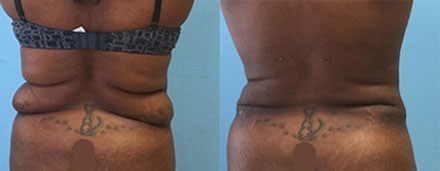Facial fat grafting is a procedure that removes fat from one area of the body and transfers it to the face to correct volume loss. It can also dramatically reduce wrinkles and fine lines. The procedure can use excess fat in areas such as the thighs or abdomen to add volume to the cheeks, lips, underneath the eyes, and diminish nasolabial folds, and forehead lines. This procedure is also known as an autologous fat transfer. Because the patient’s own fat is used, there is no risk of allergic reaction or rejection, and patients can enjoy long-lasting natural results. (1)
As we age, the effects of time and gravity become visible on the face. We may experience wrinkles, lines, and folds, or volume loss in the cheeks, nose, or eyes. Facial fat grafting can help restore a more youthful appearance and give patients a boost of confidence. Facial fat grafting can add volume and plumpness to the face for a revitalized, more ageless appearance. Dr. Saira H. Saini and the team of Carolina Plastic Surgery offer the most effective solutions for those looking to rejuvenate their appearance. If you are interested in learning more about this procedure and whether if it might be right for you, contact our Fayetteville or Ralegh office at (910) 323-1234, or through our online contact form.
About
As we age, our face naturally undergoes significant changes. Apart from the many changes that occur in our skin, we also experience changes on a structural level. The many individual pockets of fat that define our facial features atrophy and descend, leading to volume loss and sagging. However, these signs of aging, along with lines and folds can often be successfully addressed with strategic injections to restore volume and fill out creases. While dermal fillers are popular and effective, fat offers several significant advantages! It’s also a way for those with naturally thin lips or those wanting to accentuate other facial features to enjoy long-lasting results. Once the living fat cells are introduced into existing fat beneath the skin, they form a blood supply and make a healthy new home in the treatment area.
Facial fat grafting can help to address the following facial concerns:
- Hollowing of the temples and around the eyes
- Lip Augmentation
- Glabellar lines, or the 11’s found between the eyebrows
- Reduce the appearance of a dorsal hump or smooth other areas of the nose
- Enhance cheeks to lift a sagging lower face
- Add definition to the jawline and chin(1)
How Does Facial Fat Grafting Work?
The facial fat grafting procedure is a three-step process that involves harvesting, processing, and fat transfer.
- Harvesting: Fat is taken from a region of the body with excess fat. Common areas include the thighs, abdomen, or buttocks, where the deeper layers of fat cells are more likely to survive the transfer.(1) Because only a small amount of fat is needed to treat the face, surgeons can remove the needed fat using a narrow cannula, and a technique called syringe aspiration. Or, liposuction can be used for improved body contours. A small incision is made in the donor area, and the area is infiltrated with tumescent fluid, which numbs the area, makes fat easier to remove, and reduces bleeding. Once it has taken effect, a cannula is inserted, and as the plunger of the attached syringe is withdrawn, the donor fat is removed.
- Processing: The harvested fat then goes through a purification process. Contaminants, oil, and dead fat cells are removed using a filtration process, leaving only healthy, mature fat cells. This reduces the risk of inflammation and increases the likelihood that the fat cells will survive.(2)
- Fat Transfer: Once the fat has been prepared for injection, a special cannula is inserted into the recipient area. As the cannula is withdrawn, the surgeon depresses the plunger, leaving aliquots, or small deposits of fat placed along the way. This, and other injection techniques, ensures that the fat is evenly distributed and that each aliquot has sufficient contact with the surrounding tissues in order to graft. This process will be repeated in various depths of the treatment area, allowing the surgeon to sculpt the area, and achieve the desired effect.
Benefits
Benefits of facial fat transfer include the following:
- Low-risk procedure
- Minimally invasive
- Long-lasting results
- Reduces the appearance of fine lines and wrinkles
- Considered an effective alternative to dermal fillers or neuromodulators
- Restores volume loss in cheeks, underneath the eyes, lips, and other areas of the face
Another important benefit of using harvested fat is that it contains naturally occurring stem cells. In fact, several recent studies have shown that adipose tissue (fat) has the highest amounts of adult stem cells found anywhere in the body! These cells have the ability to “differentiate” or become different kinds of cells, including additional adipose, or fat cells.(2)
Candidates
You may be a good candidate for facial fat grafting if:
- You are in generally good health and at a stable weight.
- You experience age-related facial volume loss.
- You have realistic expectations of the procedure.
- You have adequate fat stores throughout the body to transfer.
You may not be a good candidate for facial fat grafting if a high likelihood exists for unstable fat volume, such as via weight fluctuation, or if you had a prior fat transfer procedure where the body reabsorbed the majority of the fat that was grafted. (1)
Personal Consultation
Dr. Saini is a board-certified plastic surgeon who has spent her decades of practice focused on providing unparalleled patient care. She works closely with each of her patients to find the most effective way to address their unique concerns. Facial fat grafting is just one of the many services she offers to ensure her patients’ overall wellness and self-confidence. During your consultation, she will examine your facial structure, paying special attention to the areas that you would like to treat, as well as potential donor sites. If she determines that you would benefit from a fat transfer, she will review the steps of the procedure. You’ll have the opportunity to learn more about what to expect from the procedure, and to ask any questions you may have. If you are ready to get started, contact us today at our Fayetteville or Raleigh offices at (910) 323-1234, or through our online contact form. And if you want to learn more about the other procedures we offer, check out our blog!
Preparation
Taking the time to prepare adequately will help maximize results and minimize side effects from the procedure. You’ll be given detailed instructions.
In the weeks leading up to your procedure, avoid:
- Smoking and products containing nicotine.
- Blood-thinning medications, vitamins, and supplements to prevent excess bruising or swelling–this includes NSAIDs, like aspirin, and ibuprofen, as well as Vitamin E, ginkgo Biloba, and St. John’s Wort.
Procedure
Facial fat transfer can be performed using local anesthesia and typically takes between 1 and 2 hours. To begin, Dr. Saini will harvest fat from donor sites that may include the thigh, abdomen, buttocks, flanks, or another region with excess fat stores. She will then utilize a small needle with a cannula to suction fat from the donor site. The fat will then undergo a filtration process which removes damaged cells and additional fluids such as anesthetic solution, oil, and blood. Once the healthy fat cells have been separated out, this fat will be injected into various treatment sites along the face.
Recovery
After your procedure, you may experience mild bruising, soreness, and/or swelling around the donor sites and treatment areas. These symptoms usually resolve within a few days post-treatment, and patients are fully recovered in about 10 days.
Results
After your facial fat transfer, you’ll be able to look forward to results that include improved facial contours with increased volume and smoothness. Not all of the transferred fat will graft successfully, so surgeons typically overfill the treatment areas to account for this. After the first few months, only the surviving fat will remain. By the sixth to the ninth month, the grafted fat will attain its optimal volume, and you’ll be able to enjoy your final results!
Corresponding & Complementary Procedures
Facial fat grafting can be done in conjunction with a Platelet Rich Plasma (PRP) treatment which helps to increase the rate of fat survival. PRP treatment enriches a patient’s blood plasma with platelets to improve healing and optimize recovery and results for fat transfer. Facial fat transfers are also performed to enhance the results of a facelift. Strategic additions of transferred fat can help smooth and fine-tune the youthful volume this procedure achieves, while the adipose-derived stem cells contribute to healthy tissue.
Cost of Facial Fat Grafting in Fayetteville
The cost of facial fat transfer will vary from patient to patient. And, because the results of a fat transfer are difficult to predict, it is possible that more than one procedure may be required. We will be glad to provide an approximate cost estimate in a consultation.
References
- Vasavada A, Raggio BS. Autologous Fat Grafting For Facial Rejuvenation. [Updated 2022 Sep 16]. In: StatPearls [Internet]. Treasure Island (FL): StatPearls Publishing; 2022 Jan-. Available from: https://www.ncbi.nlm.nih.gov/books/NBK557860/.
- Shauly O, Gould DJ, Ghavami A. Fat Grafting: Basic Science, Techniques, and Patient Management. Plast Reconstr Surg Glob Open. 2022 Mar 18;10(3):e3987. doi: 10.1097/GOX.0000000000003987. PMID: 35317456; PMCID: PMC8932485.




